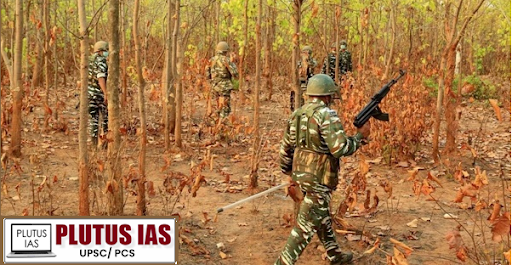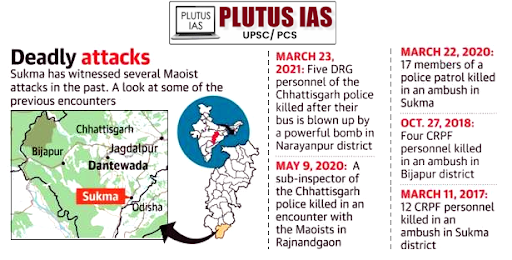04 Sep “Confronting the Menace: Left-Wing Extremism as a Challenge to National Security”
This article covers the “Daily Current Affairs” topic- Left-Wing Extremism (LWE) as a challenge to internal security.
Syllabus mapping:
GS-3: Internal Security- Left-wing extremism as challenges to the internal security.
For Prelims:
What is left-wing extremism, various schemes to eradicate it, manager organizations involved, special operations, and names of those operations?
For Mains:
How the left-wing extremism (LWE) has been originated in India?
What challenges are posed by the LWE?
what are the measures taken by the government and what measures need to be taken to eradicate the LWE?
Why in the News?
Nine Maoists were killed in a confrontation with security forces in Chhattisgarh. The clash occurred in the border area between Dantewada and Bijapur districts in the Bastar division. The encounter happened near Endri village, in the vicinity of the Bailadila hills, following intelligence reports of a Maoist presence in the area. In addition to the fatalities, security forces recovered a self-loading rifle and two other rifles from the scene. The search operation is ongoing.

Left Wing Extremism (LWE)
Origin of Left-Wing Extremism
Beginnings (1967): The movement began in Naxalbari, Phansidewa, and Khoribari in West Bengal’s Darjeeling District, led by Charu Majumdar, Kanu Sanyal, and Jangal Santhal from the Communist Party of India (Marxist).
Early Revolt: It started as a peasant revolt.
Formation of CPI (M-L) (1969): Two years later, the Communist Party of India (Marxist–Leninist) was established.
Spread: Initially in West Bengal, the movement expanded to rural areas in southern and eastern India, including Telangana, Andhra Pradesh, Odisha, and Chhattisgarh.
Current Groups: Most Naxal groups trace their roots to CPI (M-L). The Maoist Communist Centre (MCC) was formed in 1975 and merged with the People’s War Group in 2004 to create CPI (Maoist).
Prevalence of Maoism in India
History: Maoist attacks, or Left-Wing Extremism, have been present in India for about 50 years.
Casualties: Approximately 15,000 lives have been lost due to Naxal violence in the last 25 years.
Early Movement: The movement started in the 1960s, led by Charu Mazumdar. It seemed to wane after he died in 1972.
Revival: Despite setbacks, the People’s War group formed in 1980 kept the movement alive. The merger of the People’s War and MCC in 2004 led to the formation of CPI (Maoist), which revived and spread the movement.
Current Status: As of February 2024, Maoist extremism affects 90 districts across 11 states in India, known as the Red Corridor.

Factors Responsible for the Rise of Left-Wing Extremism (LWE)
Tribal Dissatisfaction: The Forest (Conservation) Act of 1980 restricted tribes from using forest resources crucial for their livelihoods, leading to dissatisfaction.
Displacement: Development projects, mining, and other initiatives have displaced tribal populations in LWE-affected areas.
Exploitation of Vulnerable Individuals: Those without sustainable support are more likely to join the Naxalite movement, which recruits them by offering weapons, money, and resources.
Socio-Economic Gaps: The government often measures success based on reduced violence rather than focusing on long-term developmental efforts in affected areas.
Lack of Technical Intelligence: Ineffective strategies against Naxalism result from insufficient technical intelligence and information.
Poor Post-Control Administration: After police regain control, essential services often fail to reach local populations, leaving them unsupported and vulnerable.
Confusion in Approach: There is a lack of consensus on whether Naxalism should be addressed as a social issue or a security threat. State governments often view it as a central government responsibility, leading to insufficient local proactive measures.
Threats Posed by Left-Wing Extremism (LWE)
Election Interference: Maoists intimidate locals before elections, preventing them from voting and undermining participative democracy.
Violent Tactics and Guerrilla Warfare: They use guerrilla tactics to impose their governance in local villages.
Destruction of Infrastructure: They damage roads, transportation systems, and government resources, obstructing governance and connectivity.
Urban Naxals: Operating under the guise of NGOs or social organizations, urban Naxals question the use of force by government authorities. This helps them garner support and build a network of sympathizers and volunteers in cities and on social media.
Extortion and Abduction: They engage in extortion and kidnap important figures such as politicians, bureaucrats, and police personnel to make demands.
Recruitment of Vulnerable Individuals: They recruit vulnerable people with low literacy, unemployment, or low income, particularly among tribals who are often unaware of the consequences, thereby expanding their cadre.
Political Nexus: They maintain connections with politicians to leverage political channels for their demands.
Attacks on Law Enforcement: They target police and government institutions to acquire weapons and technology for combatting security forces.
Government Measures to Counter Naxal Violence
Holistic Approach: The government has adopted a comprehensive strategy combining security measures with developmental efforts to address the Naxal issue.
Bandyopadhyay Committee (2006): This committee identified poor governance, economic deprivation, socio-political, and cultural discrimination against tribals as key factors fueling Naxalism. It recommended tribal-friendly land acquisition and rehabilitation to mitigate these issues.
Infrastructure Development (2017): In May 2017, the Indian Government allocated Rs 11,000 crore to enhance road connectivity in 44 districts affected by Maoist activity.
Road and Bridge Construction: By 2018, 1,326 km of roads were built in Bastar, Rajnandgaon, and Surgujia, which are heavily impacted by Naxalism. Additionally, 995 bridges were constructed, including 138 in the most affected area of Bastar.
Public Works Budget (2016-17): The annual budget for Chhattisgarh’s Public Works Department was Rs 7,795 crores, focusing on infrastructure development in Naxal-hit areas like Sukma.
Basic Facilities and Employment: Efforts are being made to provide local villagers with essential services such as healthcare, education, and employment opportunities.
Increased Surrenders: Development initiatives and efforts to disrupt Naxal funding contributed to an increase in surrenders in Jharkhand, with the number rising from 676 in 2014 to 1,442 in 2016.
Current Trends of Left-Wing Extremism (LWE)
A. Reduction in Violence:
1. Union Home Minister Amit Shah reported a 76% decrease in LWE-related violence in 2022 compared to 2010, attributed to a three-pronged strategy: a ruthless approach to violence, improved coordination with affected states, and development through public participation.
2. Naxal violence has dropped by 77% over the past 12 years, with related deaths reduced by 90%.
B. Decline in Geographical Spread: The number of districts under the Security Related Expenditure (SRE) scheme decreased from 126 in 2010 to 90 in April 2018, and further to 70 in July 2021.

Reasons for the Decline in LWE Extremism
Increased Security Presence: Greater deployment of security forces in affected states.
Leadership Loss: Arrests, surrenders, and desertions of Naxal leaders.
Rehabilitation Programs: Government efforts to rehabilitate affected populations.
Improved Monitoring and Resource Constraints: Enhanced monitoring and reduced availability of funds and arms for Naxal groups.
Intelligence Sharing: Effective intelligence sharing and establishment of specialized battalions like the COBRA and Bastariya battalions.
Government Initiatives to Fight LWE
1. Operation Green Hunt: Launched in 2009-10, this involved a large-scale deployment of security forces in Naxal-affected areas.
2. Aspirational Districts Programme: Started in 2018, this program aims to rapidly develop districts lagging in key social areas.
3. SAMADHAN Doctrine:
A comprehensive strategy for addressing LWE, including:
Smart Leadership
Aggressive Strategy
Motivation and Training
Actionable Intelligence
Dashboard-Based KPIs and KRAs
Harnessing Technology
Action Plan for Each Theatre
No Access to Financing
4. ROSHNI Initiative: Part of the Pandit Deen Dayal Upadhyaya Grameen Kaushalya Yojana, launched in June 2013, this initiative focuses on training and placement of rural youth from 27 LWE-affected districts.
5. Road Connectivity: Sanctioned construction of 17,462 km of roadways, with 11,811 km completed.
6. Mobile Connectivity: Installation of 2,343 mobile towers in the first phase, with 2,542 new towers planned for the second phase.
7. Ekalavya Residential Model Schools: More than 100 schools were sanctioned before 2019, with an additional 103 sanctioned in the past three years. A total of 245 schools have been sanctioned in 90 LWE-affected districts, with 121 operational.
8. Financial Inclusion: Opening of 1,258 bank branches, 1,348 ATMs, and 4,903 post offices in the worst-hit districts.
Counter-Insurgency Efforts
Salwa Judum: A local peace force established by villagers in response to Naxal interference, involving former Naxalites and local tribals.
Grey Hounds: An elite commando force from Andhra Pradesh known for its effectiveness against Naxalites, employing guerrilla tactics similar to those used by the Maoists.
Operation Green Hunt: An extensive offensive by paramilitary and state forces to combat Naxalites.
New Emerging Developments
Expansion to New Areas: Naxal groups are spreading into previously unaffected regions.
Increased Militarization: Rising militarization within Naxal groups.
Targeted Killing of Informers: Focus on eliminating suspected informers to hinder intelligence gathering.
Propaganda and Civil Society Engagement: Enhanced propaganda efforts through civil society groups and social media.
Urban Penetration: Attempts to infiltrate urban areas and engage with working-class movements.
Over-Ground Organizations: Establishment of organizations to support their agenda.
Use of Technology: Employing technology for communication and propaganda.
Extortion: Large-scale extortion from contractors and industries in Naxal-dominated areas.
Issues in Government Measures
Intelligence Gaps: Traditional intelligence-gathering methods, such as police receivers on hills, have proven ineffective. Recent attacks have exploited these gaps.
Large Troop Operations: Larger forces are believed to provide better protection, but recent attacks have revealed vulnerabilities.
Trust Deficit: A lack of trust between local populations and security forces due to cultural differences and external appearance.
Protection of Informers: Informants often face torture and death at the hands of Maoists.
Approach to Tackling LWE: The focus is often on security measures rather than addressing the socio-economic and political roots of the issue.
Local Politician Support: Some local politicians covertly support Naxal activities, undermining anti-LWE efforts.
Way Forward
Peace Agreements: The government and Maoists should negotiate peace agreements similar to the Mizo Accord.
Comprehensive Development: Ensure all-round development of Naxal-affected areas.
Local Engagement: Employ more local personnel in administrative roles to bridge the trust deficit and involve civil society in supporting tribal communities.
Small-Scale Operations: Use small, efficient teams like the Greyhounds for better results.
Careful Policy Implementation: Implement policies that provide indirect benefits, such as the Forest Rights Act, of 2006, with careful consideration.
IED Prevention: Develop innovative measures to prevent IED-related incidents.
Capacity Building: Focus on capacity-building and modernization of local police forces.
Surrender Policy: Rationalize surrender policies to reintegrate individuals caught in LWE into mainstream society.
Focused Approach: Adopt a time-bound approach to eliminate LWE groups and ensure comprehensive development of affected regions.
Youth Unemployment: Address the youth bulge and unemployment issues to prevent internal security threats.
Synchronized Efforts: The Centre and states must work together to eliminate radicalization and support affected populations.
Conclusion
In a nutshell, effectively addressing Left-Wing Extremism (LWE) necessitates a holistic approach that goes beyond mere security measures. It is vital to tackle the underlying socio-economic issues faced by poor and tribal communities, as this will help undermine the appeal of extremist ideologies. Investing in infrastructure development, such as roads and railways, will not only boost economic growth but also counteract Maoist propaganda. Moreover, in a democracy that provides legitimate avenues for grievance redressal, an ideology rooted in violence is destined to fail. Therefore, a balanced strategy that integrates both development and security interventions is essential for successfully combating LWE and ensuring long-term peace and stability.
Download plutus ias current affairs eng med 4th Sep 2024
PRELIMS QUESTION:
Q. Consider the following measures:
1. Providing the armed forces with advanced weaponry.
2. Ensuring the safety of citizens living abroad.
3. Establishing robust systems to address cybercrimes.
4. Implementing strict laws and ensuring their enforcement to combat corruption.
How many of the given- above measures, will strengthen Internal security?
A. Only one
B. Only two
C. Only three
D. All four
ANSWER: C
Mains Question:
Examine the role of local governance and community involvement in the counter-insurgency efforts against Left-Wing Extremism. How can local administrative bodies and community organizations contribute to a more effective and sustainable solution to the LWE problem?
(250 words 15 marks)




Priyanka
Posted at 17:04h, 04 SeptemberVery comprehensive